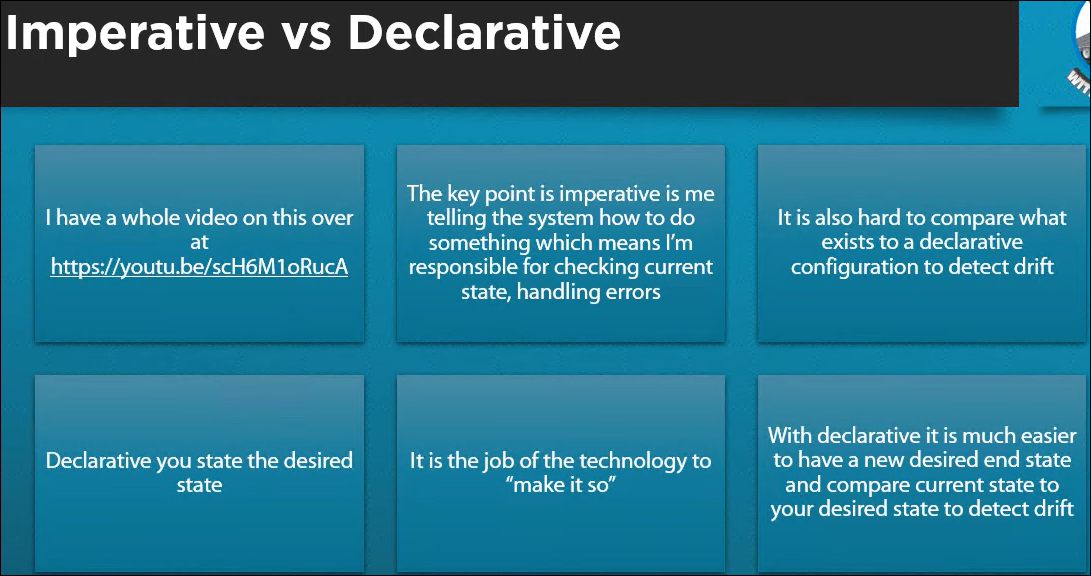Terraform with John Savil
Training Video: Using Terraform with Azure - YouTube from 2021

Imperative vs Declarative

Azure loves Declarative
- Resources can be provisioned imperatively using REST API, PowerShell, AZ CLI, and the portal however at its foundation Azures state is stored as JSON.
- Resources are best provisioned using templates
- Natively Azure uses JSON-based ARM Templates
- This is Azure specific and not usable across clouds or for other types of resource
Terraform 101
- Terraform is a declarative technology created by HashiCorp
- It uses Terraform text-based configurations with a .tf file type enabling source control integration
- Terra is written in Go and available across platforms as a single binary which you place in the systems path
- Terraform is the terraform.exe in Windows
- Providers are being automatically installed if needed
- Terraform is natively available in the Azure cloud shell
Terraform Key phases
- We have to create Create Terraform configuration
- Consists typically of 3 files
main.tf(my declarative configuration)variables.tfoutput.tf(to output information at the end of the job)
- Consists typically of 3 files
- Initialize Terraform configuration
terraform fmt- formats the files correctly and fixes all the tf files in the folder
terraform init- passthrough the files
- what plugins are being referenced
- automatically downloads them
- only run once
- View the changes that will be applied
terraform plan- checks what actions need to be performed
- is comparing to the statefile
- creates .terraform folder
- Apply the changes
terraform apply- asks for approval, a-auto-approve can be used
- creates tfstate file
- the current state of a resource can be changed by running the command again
- to change form LRS to GRS
terraform plan -var 'replicationType=GRS"
- to change form LRS to GRS
- terraform show
- shows the tfstate file in a better format
- To visualize
terraform graph- to export
terraform graph > base.bot - can be exported to SVG with Graphviz https://graphviz.org/
Graphviz / graphviz · GitLab
terraform graph | dot -Tsvg > graph.SVG
- to export
- Resolving State Drift
- terraform refresh
- If the infrastructure changes outside of Terraform update files
- terraform refresh
Tips
- Parameters can be passed, for example:
terraform plan -var 'replicationType=GRS"terraform apply -var 'replicationType=GRS' -auto-approve
Terraform State
- The Terraform Core is responsible for a number of things including state management
- Terraform stores the state of managed resources
- Terraform creates backups of the tfstate files
- This provides the mapping of resource reality to your resource desired configuration
- State files also track metadata
- State is stored in a local terraform.tfstate file which should NOT be manually edited
- Resources managed by Terraform should NOT be modified outside of Terraform
If you are working as a team you must ensure the latest state file is used and nobody uses it at the same time. Remote state along with state locking can assist.
Secrets shouldn't be readable in state files
- Remote backend with Azure Storage can help
Terraform Code (HCL)
- Is the declarative language used in the Terraform files
- Documentation as Code
- About 30% less effort to develop compared to ARM
Anatomy of a Terraform File
-
Resource
-
Resource use the same format no matter what the provider
resource "type" "name"{
parameter1 = "value"
parameter2 = "value"
}
-
-
Complete
-
A provider section optional version information
# Provider Block
provider "azurerm" {
version = "=2.11"
features {}
} -
Data source section to reference existing resources
-
Resource section
-
-
Variable file
-
variables.tf
-
Enables separation of environmental specific values
variable "environment" {
description = "Environment Name"
type = string
#default = "dev"
} -
Main configuration can be version controlled and unmodified between environments and instances
-
Variables are declared and default values can be specified
-
If no default the user will be prompted
-
Can also be set as part of the command line, terraform.tfvars, or environment variables
-
-
Output file
-
Messages and data to be displayed post apply
output "resource_group_name" {
description = "Resource Group name"
# Argument Reference
value = azurerm_resource_group.myrg.name
}
Azure Resource Provider
- Currently at second major version (v2)
- Close partnership with Microsoft ensures up-to-date with Azure developments
- Existing resources must now be imported into state before they can be managed via Terraform
- As an official plugin distributed by HashiCorp it does not need to be manually installed
Creating Azure Resources
- Number of quick starts are available at
- Docs overview | hashicorp/azurerm | Terraform Registry Has details on authentication and types of resource
-
Interacting with Azure Key Vault
-
Key vault secrets can be used to store sensitive data you do not want in variable or state files
-
Ensure the account running Terraform has rights to the secrets in the vault
-
Secrets referenced just like any other data source
-
Example to get a password;:
variable "KV" {} #This will pull in value from TF_VAR_KV set in environment variable
data "azurerm_key_vault_secret" "SamplePassword" {
name = "SamplePassword"
key_vault_id = "${var.KV}"
}
output "A_Secret_From_KeyVault_Shhhhh" {
value = data.azurerm_key_vault_secret.SamplePassword.value
}
Other Useful Components
- File Provisioner
- Used to copy files into a remote machine
- Remote Exec Provisioner
- Trigger commands on a remote machine
Azure DevOps and GitHub Integration
- Ideally your code is checked in and deployments are automated via pipelines
- There is a marketplace extension for Azure DevOps that adds Terraform tasks to pipelines
- HashiCorp has a setup-terraform GitHub action which adds terraform to the path making its capabilities available
Calling ARM Templates from Terraform
- While possible this is discouraged
- HashiCorp work closely with Microsoft to ensure the Azure provider is up-todate
- There is an azurerm_template_deployment that enables ARM JSON to be specified however the created resources will not be managed by Terraform